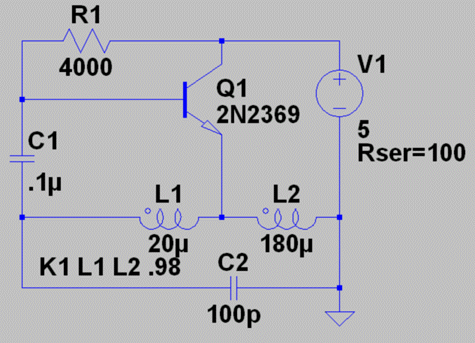
Figure 1. Schematic of a squegging Hartley oscillator as displayed in SwitcherCAD III for Windows.
In wildlife management, very few tracking transmitters send some form of "station identification." Radio tags for birds and small mammals can't. These little devices must put out a signal to a ground range of a mile or so for up to a year or more, yet weight only a few grams, including battery. To do that, most of them consist of simple blocking or relaxation oscillators with only a few discrete components. You may hear the term "squegging oscillator" used to describe them.
Early regenerative receivers used positive feedback to increase gain and sensitivity without adding expensive tube stages. If you adjusted the controls for too much feedback, the radio would intermittently squeal or make a put-put sound, called "motorboating" or squegging. The advent of superheterdyne receivers took squegging out of the vocabulary of most radio enthusiasts. But in today's wildlife radio tags, this phenomenon is still put to good use.
If you set out to design a transmitter that sent "dits" of a few milliseconds duration every second or so, your first concept might have two stages, a keyer and a transmitter. Maybe you would pick a timer IC such as the venerable 555 for the keyer and a transmitter IC such as the MC2833. I often use just such a 10-milliwatt mini-T for everyone to test their RDF antennas before our southern California radio-orienteering events. But with all the other discrete components needed to support these ICs, there is no way to make that design tiny and lightweight enough to put on a small bird.
A squegging oscillator is an elegant two-for-one solution to the problem. Figure 1 shows how simple it can be. If you have studied for your Extra Class ticket, you'll remember that a Hartley oscillator has a tapped inductor that provides feedback to sustain oscillation. (And if you took your test 25 years ago as I did, you'll remember having to do freehand drawings of Hartley and Colpitts oscillators as part of the test!) L1 and L2 form the tapped inductor in this case. Both are wound on the same form for tight coupling, indicated by coupling factor (K) of 0.98 in the schematic.

Figure 1. Schematic of a squegging Hartley oscillator as displayed in SwitcherCAD III for Windows.
The combined inductance of L1-L2 is resonated by C2 to set the oscillator's RF output frequency. The RF would be continuous if feedback conditions were stable. But in this circuit, C1 charges in just a few RF cycles and saturates the transistor, then discharges more slowly. The result is short periods of oscillation, as shown in the waveforms of Figure 2.
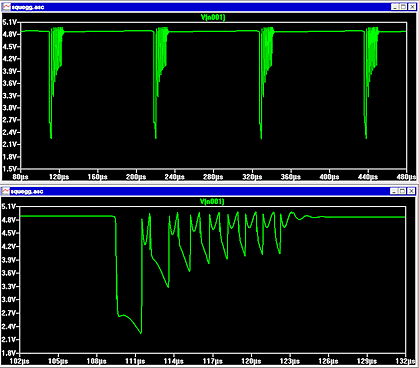
Figure 2. Transient analysis output of SwitcherCAD shows the RF oscillation that trails off and stops after eight cycles, then repeats at regular intervals.
Figures 1 and 2 were created in SwitcherCAD III, a freeware circuit analysis program from Linear Technology Corporation, based on the classic SPICE analytical engine. To learn more about squegging oscillators, download the program, input this circuit, and run a transient analysis. Then try varying the component values to see what happens to the RF dit rate, dit duration, and RF frequency.
The output of this rudimentary L-C Hartley oscillator has very high harmonic content, as the lower trace of Figure 2 shows. It would also have very poor frequency stability in an animal tag, due to temperature changes, varying proximity to the critter, coil movement, and battery voltage sag. (But it's stable enough for the "Electronic Golf Ball." Take a look at U.S. Patent 3,782,730 at the U. S. Patent Office Web site.)
Micro-tags for research solve those problems with crystal-controlled oscillators, but their pulsing scheme is almost the same. The characteristics of the pulsing can be used as a form of ID.
Beginning in 1998, I have asked hams and other monitoring enthusiasts to carefully tune their VHF receivers in hopes of picking up radio tags that researchers have place on migrating birds. The good news is that there are now many hams who are willing to do such monitoring. The bad news is that relatively few of them can do the direction finding necessary to verify the sources of the signals they hear. That makes it important to do the verification in other ways. There is a sound file of an actual squegging radio tag in the Homing In Web site, and some hams have reported signals that sound "just like the file." But were they? I have asked respondents to provide either WAV files or cassette tapes of what they heard. There have been differences in every one I have received so far, sometimes subtle and sometimes glaring.
There are lots of sound analysis programs for PC, Mac and other platforms. Many are freeware or inexpensive shareware. I am using WaveSurfer 1.4.5 from the Center for Speech Technology in Stockholm, Sweden. It directly opens WAV files and performs both time and frequency domain analysis. Figure 3 is the WaveSurfer display of the actual biotag, taken from the audio output of a receiver in the SSB/CW mode. RF dits are 20 milliseconds long and about 1.5 seconds apart, with no variation in duration or rate. Notice the downward "tilt" of the dit envelope, which is characteristic of the diminishing output of a squegging oscillator. Also notice the 30-millisecond "rat-tail" after the dit, caused by lingering low-level operation of the oscillator.
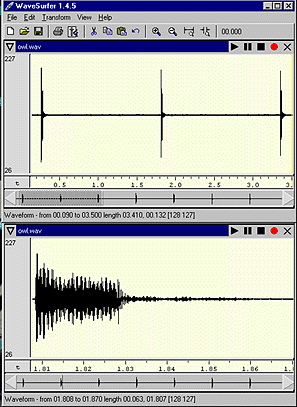
Figure 3. WaveSurfer display of an Burrowing Owl radio tag. At the top, a train of dits, precisely spaced. At bottom, a close-up of a single dit.
Compare this actual owl tag signal to Figure 4, the first volunteer sound file, sent by a ham shortly after the fall 2002 announcement went out. When I played the file, the transmissions sounded more like clicks than beeps, and the pulsing rate seemed somewhat irregular. The WaveSurfer display shows why. In the top trace, the clicks are not evenly spaced over time. In the expanded trace on the bottom, each click is only a single cycle. It's probably some sort of quasi-periodic noise.
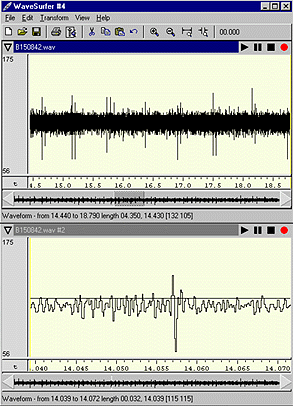
Figure 4. It's easy to see that this volunteer's WAV file is not from an actual radio tag, even though the clicks sound somewhat similar.
My ears were enough to quickly rule out that file as a possible owl tag, but the signal of Figure 5, which was sent by another volunteer, wasn't as easy. I was suspicious, because the dits were too "clean" sounding and their rate was more rapid than anticipated. Sure enough, WaveSurfer showed that the blips were exactly one second apart, as if from some clock device. They were too long (80 milliseconds), too square (very sharp rise and fall of the RF envelope), and there was no rat-tail. So this signal isn't an owl tag either, unfortunately.
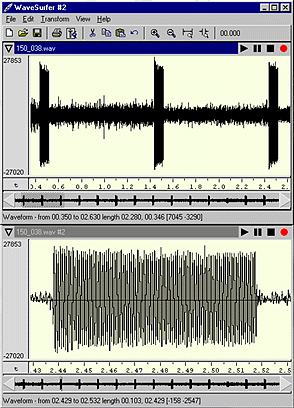
Figure 5. Despite its similarities in sound and waveform, this is also not an owl radio tag.
Although not shown in the figures, WaveSurfer will perform fast Fourier transforms (FFTs) of the WAV file to display audio frequency components versus time. The pitch of a tone burst on a CW receiver varies with the BFO setting, but observing the steadiness of that tone might further refine the ID process. Try it.
Text and illustrations copyright © 2002 and 2008 Joseph D. Moell. All rights reserved.
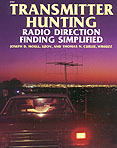 Back to the Frequently Asked Questions About Wildlife Tracking page of this site
Back to the Frequently Asked Questions About Wildlife Tracking page of this site
Back to the New Wildlife Tracking Projects page of this site
Back to the Homing In Radio Direction Finding home page
 This page updated 22 October 2008
This page updated 22 October 2008